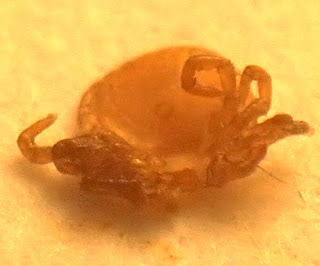 |
| Tic on a tweezers tip |
"In the spring, a young tick's fancy, turns to thoughts of blood." - with apologies to Tennyson
A 70 degree day on March 3rd prompted me to lay down and stare up into the barren winter trees in our upland forest. It was 16 days until Spring officially starts and the only signs were a slight plumping up of buckeye buds and an occasional small swarm of midges.
A small itching bump on my hip the next day introduced me to the first tick of 2022. It took a magnifier to convince us there was even something there. We previously reported a Christmas tick on December 26th, 2020.
 |
| Lone Star ticks - Entomology- University of Florida |
 |
| 1.3 mm larva |
 |
| 6 legs = larva |
It is commonly thought that ticks die off in the winter after the first hard frost. Unfortunately, they do not. The tick lifecycle on average is about two years. This means that ticks in cold winter climates have to survive spells of below-zero temperatures. They spend the winter in a low energy state but can revive on warm days and wake up mighty thirsty.
Ticks' winter survival is complex. Some can survive up to -7 degrees. One key depends on their micro-climate. Dry arid landscapes put them at greater risk while moist and humid soil with leaf litter provides a degree of insulation. Prolonged cold spells increase mortality while mild temperatures and global warming increase their survival.
 |
| Frontal view-Click to enlarge |
While blood-fed ticks can emerge and quest for food and mating, unfed larva need warmer temperatures to emerge and feed to enter the next life stage. Two days of 70 degrees with 30 degree nights was all this little sucker needed to quest. Add a warm body on the ground and the larva's survival is ensured.....unless a pair of tweezers attack!
University of Florida entomology site is my go-to resource for a wide variety of insects. The Tick Research Lab of Pennsylvania has more studies on tick survival in winter.
--------------------------------------
Addendum March 9, 2022
 |
| Male Lone Star Tick |
I now face a moral dilemma. As an ethical ecologist, am I obliged to release it along the road where it found me or can I drop it off in the National Forest?